
PROCEEDINGS OF THE INDIAN ACADEMY OF SCIENCES-MATHEMATICAL SCIENCES
Scope & Guideline
Advancing Mathematical Frontiers through Quality Research
Introduction
Aims and Scopes
- Algebra and Number Theory:
This area encompasses research related to algebraic structures, number theory, and their applications, including studies on groups, rings, fields, and the properties of various number systems. - Geometry and Topology:
Research in this scope focuses on the properties and relationships of geometric shapes and topological spaces, including differential geometry, algebraic geometry, and the study of manifolds. - Analysis and Functional Analysis:
This includes research on real and complex analysis, functional analysis, and the study of various mathematical functions and their properties. - Applied Mathematics:
This area covers the application of mathematical methods to solve real-world problems, including numerical analysis, optimization, and mathematical modeling. - Mathematical Physics:
Research in this scope involves the intersection of mathematics and physics, exploring mathematical frameworks for understanding physical phenomena. - Combinatorics and Discrete Mathematics:
This area includes studies on combinatorial structures, graph theory, and discrete mathematical problems, focusing on counting, arrangement, and optimization.
Trending and Emerging
- Algebraic Geometry and Moduli Spaces:
This theme has gained traction, with increased focus on the study of algebraic varieties and their parameter spaces, reflecting a growing interest in the geometric aspects of algebra. - Nonlinear Partial Differential Equations:
Research on nonlinear PDEs has become more prominent, driven by their applications in physics and engineering, as well as their intrinsic mathematical challenges. - Combinatorial Optimization:
The rise of combinatorial methods to solve optimization problems has become a significant trend, reflecting the increasing importance of discrete mathematics in practical applications. - Mathematical Data Science:
With the surge in data-driven research, mathematical techniques applied to data science, including statistical methods and machine learning, are emerging as a critical focus area. - Topological Data Analysis:
This new area focuses on the application of topology to understand the shape of data, highlighting the intersection of algebraic topology and data science.
Declining or Waning
- Classical Geometry:
Research centered on classical geometric constructs and their properties has seen a decline, possibly due to a shift towards more abstract or computational approaches in geometry. - Elementary Number Theory:
While still a key area, the focus on basic concepts in number theory, such as divisibility and congruences, seems to be waning as researchers pursue more complex and applied aspects of number theory. - Traditional Algebraic Structures:
The study of traditional algebraic structures like groups and rings has decreased, with a growing emphasis on more advanced and abstract algebraic concepts.
Similar Journals
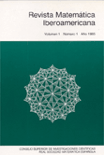
REVISTA MATEMATICA IBEROAMERICANA
Fostering collaboration in the mathematical sciences.REVISTA MATEMATICA IBEROAMERICANA, published by the EUROPEAN MATHEMATICAL SOCIETY, is a leading open-access journal dedicated to advancing the field of mathematics. Since its inception in 1996, the journal has provided a platform for high-quality research up to 2024, achieving a prestigious Q1 ranking in the miscellaneous mathematics category and placing it within the top 77th percentile of the Scopus rankings. Based in Spain, this journal fosters a vibrant academic community by disseminating innovative research, theoretical insights, and applications within the broad scope of mathematics. With its commitment to open access established in 2022, REVISTA MATEMATICA IBEROAMERICANA ensures that groundbreaking research is accessible to scholars, practitioners, and students worldwide, emphasizing the importance of collaboration and knowledge sharing in the mathematical sciences. The journal is a vital resource for anyone invested in the evolution of mathematics, providing a rich array of articles that contribute to both the theoretical and applied landscapes of the discipline.

Periodica Mathematica Hungarica
Exploring Innovative Theories and Methodologies.Periodica Mathematica Hungarica is a prestigious academic journal published by Springer, focusing on the field of mathematics, with a particular emphasis on miscellaneous mathematical studies. Established in 1971, this journal has maintained its commitment to advancing mathematical research and its applications, making significant contributions over its converged years through 2024. With a Q2 ranking in the mathematics category as of 2023, it establishes itself as a vital resource within the mathematical community. Researchers and academics will find its inclusion in the Scopus database, ranking #189 out of 399 in general mathematics, indicative of its impact and relevance. Although it does not feature open access, the journal provides a wealth of high-quality peer-reviewed articles, thereby serving as an essential platform for the dissemination of innovative mathematical theories, methodologies, and findings. Engaging with the content of Periodica Mathematica Hungarica is crucial for anyone looking to stay at the forefront of mathematical research and development.
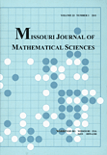
Missouri Journal of Mathematical Sciences
Advancing Knowledge Through Mathematical DiscourseThe Missouri Journal of Mathematical Sciences, published by the CENTRAL MISSOURI STATE UNIVERSITY, DEPARTMENT OF MATHEMATICS & COMPUTER SCIENCE, serves as an essential platform for disseminating innovative research and advancements in the field of mathematics. Since its inception in 2001, this journal has provided a space for scholars, professionals, and students to exchange ideas and present their findings, contributing to the growing body of knowledge in mathematics. Despite its current category quartile ranking of Q4 in Mathematics (miscellaneous), the journal aims to enhance its impact further, encouraging contributions that push the boundaries of mathematical sciences. Although it operates without an open-access model, it is dedicated to fostering academic discourse and making a meaningful impact through its publications. Researchers interested in exploring mathematical concepts will find this journal to be a valuable resource as it continues to evolve through the years up to 2024, aiming to attract high-quality submissions that showcase significant and practical advancements in mathematics.

Revista de la Real Academia de Ciencias Exactas Fisicas y Naturales Serie A-Matematicas
Elevating Research Standards in Mathematical SciencesRevista de la Real Academia de Ciencias Exactas Fisicas y Naturales Serie A-Matematicas, published by SPRINGER-VERLAG ITALIA SRL, is a premier academic journal based in Italy that serves as a significant platform for researchers and practitioners in the fields of Mathematics. With a focus on core areas such as Algebra, Analysis, Applied Mathematics, Computational Mathematics, and Geometry and Topology, this journal boasts an impressive performance in academic rankings, achieving Q1 status in multiple categories, reflecting its excellence in disseminating high-quality research. The journal is easily accessible through subscription options and provides a vital resource for the mathematics community, fostering the exploration of innovative ideas and methodologies. The journal’s commitment to advancing mathematical knowledge is evident through its competitive Scopus rankings, including a remarkable rank of #1 in Algebra and Number Theory, placing it in the top percentile of its field. Scholars and students alike will find in this publication a rich source of impactful research that not only contributes to the academic discourse but also enhances the practical applications of mathematics in today's society.

PUBLICATIONES MATHEMATICAE DEBRECEN
Fostering Innovation in Mathematical SciencesPublicationes Mathematicae Debrecen is a renowned international journal published by the University of Debrecen, Institute of Mathematics, situated in Hungary. This journal, with both ISSN 0033-3883 and E-ISSN 2064-2849, has established itself in the field of mathematics since its inception, with coverage extending from 1997 to 2024. Recognized for its rigorous academic standards, it currently holds a Q3 ranking in the mathematics (miscellaneous) category for 2023 and ranks at the 42nd percentile among general mathematics journals in Scopus. Publicationes Mathematicae Debrecen aims to disseminate high-quality research across various areas of mathematics, contributing to the advancement of knowledge and practice in this dynamic field. Although it is not an open-access journal, its readers can access a wealth of scholarly work that addresses both theoretical and applied mathematical issues, making it an invaluable resource for researchers, professionals, and students alike.
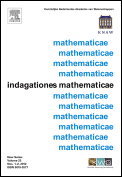
INDAGATIONES MATHEMATICAE-NEW SERIES
Illuminating the complexities of mathematics through rigorous inquiry.INDAGATIONES MATHEMATICAE-NEW SERIES is a distinguished academic journal specializing in the field of mathematics, with a focus on both theoretical and applied aspects of the discipline. Published by Elsevier, a leading publisher in the scientific community, this journal has established itself as a crucial platform for the dissemination of high-quality research. With an ISSN of 0019-3577 and an E-ISSN of 1872-6100, it operates out of the Netherlands and has been a vital resource for academics since its inception in 1969. Currently, it holds a Q2 ranking in the mathematics category, signifying its relevance and impact in the field, with a Scopus rank of #222 out of 399 in General Mathematics, placing it in the 44th percentile. Although it does not currently offer Open Access options, INDAGATIONES MATHEMATICAE-NEW SERIES is committed to contributing to the advancement of mathematics by publishing original research articles, reviews, and notes that enrich the academic community. Researchers, students, and professionals alike will find invaluable insights and developments within its pages, making it a cornerstone journal for those keen on exploring the complexities of mathematics.
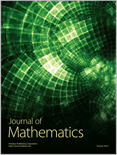
Journal of Mathematics
Cultivating dialogue among mathematics enthusiasts.Welcome to the Journal of Mathematics, a premier open access journal published by Hindawi Ltd, dedicated to advancing knowledge in the diverse realm of mathematics. Since its inception in 2013, the journal has provided a platform for the dissemination of significant mathematical research and applications, achieving recognition in the 80th percentile of the general mathematics category as per Scopus rankings. With a commitment to fostering academic collaboration and accessibility, the journal promotes critical dialogue among researchers, professionals, and students alike. Located in the vibrant academic hub of London, England, the Journal of Mathematics continues to enhance its impact within the mathematical community, as evidenced by its Q3 classification in mathematics (miscellaneous) for 2023. Join us in exploring groundbreaking research and innovations, as we converge towards the future of mathematical sciences through our open access model.

Research in the Mathematical Sciences
Elevating the Standards of Mathematical ScholarshipResearch in the Mathematical Sciences is a prestigious journal published by Springer International Publishing AG, specializing in a diverse range of mathematical disciplines. With an ISSN of 2522-0144 and an E-ISSN of 2197-9847, this journal operates out of Switzerland and has established a reputation for excellence in research dissemination since its inception in 2014. The journal is currently ranked in the highly regarded Q2 quartile for Applied Mathematics, Computational Mathematics, and Mathematics (miscellaneous), along with a Q3 rank in Theoretical Computer Science, reflecting its substantial influence within the academic community. Researchers will find great value in this journal as it features high-quality, peer-reviewed articles that contribute to the advancement of mathematical sciences. The journal promotes open access options, facilitating greater accessibility to innovative research findings. With its comprehensive scope and strong Scopus rankings, Research in the Mathematical Sciences serves as an essential resource for academics, professionals, and students eager to stay at the forefront of mathematical research and its applications.
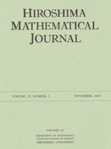
Hiroshima Mathematical Journal
A Legacy of Mathematical Research and DiscoveryThe Hiroshima Mathematical Journal, published by Hiroshima University, Graduate School of Science, serves as a prominent platform for disseminating high-quality research in the field of mathematics. Established in 1959, the journal has been an integral part of the mathematical community, focusing on areas such as Algebra, Number Theory, Analysis, and Geometry and Topology. Although currently classified in Q4 quartile rankings within its categories, the journal is committed to advancing mathematical knowledge and fostering scholarly dialogue. Its accessibility, combined with its long-standing history, makes it an essential resource for researchers, professionals, and students dedicated to exploring and enhancing the mathematical sciences. For those interested in contributing or accessing cutting-edge research, the Hiroshima Mathematical Journal continues to uphold its mission of excellence in mathematical scholarship.
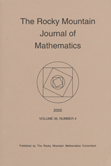
ROCKY MOUNTAIN JOURNAL OF MATHEMATICS
Pioneering Research for a Dynamic Mathematical CommunityROCKY MOUNTAIN JOURNAL OF MATHEMATICS, published by the Rocky Mountain Math Consortium, serves as a critical platform for researchers and practitioners in the field of mathematics since its inception in 1971. With a notable presence in the academic community, this journal covers a broad spectrum of mathematical disciplines, positioning itself in the Q2 category for Mathematics (miscellaneous) as of 2023. Despite being a subscription-based journal, it is recognized for its rigorous peer-review process and contributions to theoretical and applied mathematics, helping to advance knowledge and foster collaboration among mathematicians. The journal's ISSN number is 0035-7596 and its E-ISSN is 1945-3795, reflecting its commitment to accessibility and dissemination of high-quality research. Based in Tempe, Arizona, at Arizona State University, the journal continues to play an important role in shaping contemporary mathematical discourse through well-researched articles and innovative studies, aiming to bridge gaps between various mathematical subfields and engage a diverse audience, including students and established researchers alike.